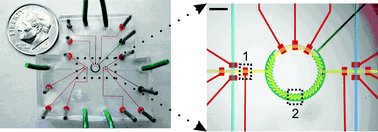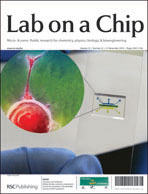We report a mechanistic study of how flow and recirculation in a microreactor can be used to optimize the capture and release of stimuli-responsive polymer–protein reagents on stimuli-responsive polymer-grafted channel surfaces. Poly(N-isopropylacrylamide) (PNIPAAm) was grafted to polydimethylsiloxane (PDMS) channel walls, creating switchable surfaces where PNIPAAm–protein conjugates would adhere at temperatures above the lower critical solution temperature (LCST) and released below the LCST. A PNIPAAm–streptavidin conjugate that can capture biotinylated antibody–antigen targets was first characterized. The conjugate's immobilization and release were limited by mass transport to and from the functionalized PNIPAAm surface. Transport and adsorption efficiencies were dependent on the aggregate size of the PNIPAAm–streptavidin conjugate above the LCST and also were dependent on whether the conjugates were heated in the presence of the stimuli-responsive surface or pre-aggregated and then flowed across the surface. As conjugate size increased, through the addition of non-conjugated PNIPAAm, recirculation and mixing were shown to markedly improve conjugate immobilization compared to diffusion alone. Under optimized conditions of flow and reagent concentrations, approximately 60% of the streptavidin conjugate bolus could be captured at the surface and subsequently successfully released. The kinetic release profile sharpness was also strongly improved with recirculation and helical mixing. Finally, the concentration of protein–polymer conjugates could be achieved by continuous conjugate flow into the heated recirculator, allowing nearly linear enrichment of the conjugate reagent from larger volumes. This capability was shown with anti-p24 HIV monoclonal antibody reagents that were enriched over 5-fold using this protocol. These studies provide insight into the mechanism of smart polymer–protein conjugate capture and release in grafted channels and show the potential of this purification and enrichment module for processing diagnostic samples.

You have access to this article
 Please wait while we load your content...
Something went wrong. Try again?
Please wait while we load your content...
Something went wrong. Try again?


 Please wait while we load your content...
Please wait while we load your content...